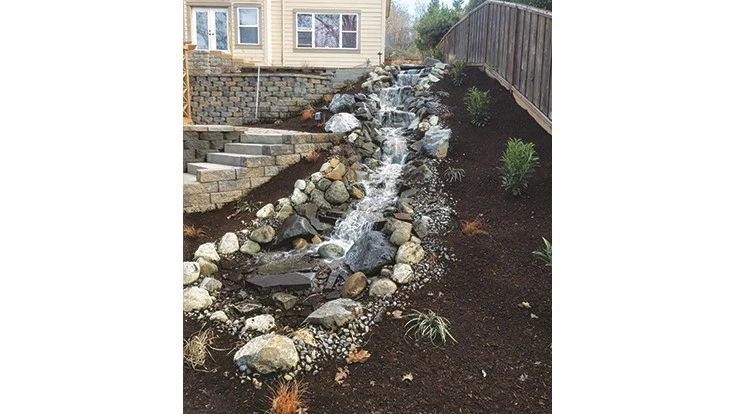
It’s no wonder water features are a luxury that property owners enjoy adding to their sites. Whether they’re commercial or residential, the sights and sounds of water can add a sense of tranquility and peace. But whenever you add water, you add maintenance, too.
“For people who don’t understand how water behaves, it’s like Murphy’s Law,” says Matt Boring, owner of Texas Ponds and Water Features in Austin, Texas. “Anything and everything that could possibly go wrong will go wrong, and at the worst possible time.”
This isn’t exactly a sales pitch, but it’s how he explains to his pond maintenance crews that water wants to escape its confines. Any means of escape can create extra maintenance issues.
“A liner edge, a wrinkle in the liner that’s hiding the escape path, a stone that transverses the liner and has water running down its underside – water will always take the path of least resistance and escape,” he says. “Water features are a completely different animal than any other type of landscape improvement.”
And when water features are not properly installed (or if they’re neglected), the maintenance required to keep them attractive and functioning properly can be time-consuming for the contractor and costly for the client.
The good news is that with consistent upkeep and careful installations, you can keep any water feature in good shape.
First, build it right.
Water features need to be properly engineered, which is why the design and installation is a specialty niche, says Gary Krause, owner of Gary Krause Landscaping and Design in Jacksonville, Oregon. Krause encourages clients to think about maintenance before they determine what type of water feature to include on their property.
“One of the things I’ll ask is, ‘How much maintenance are you willing to do?’” Krause says.
He also asks, “Why do you want it?” Some prefer the sound of falling water, while others want to gaze at a pond. Water features vary in design and maintenance requirements, so determining how committed the owner is to upkeep is an important first step.
Potential problems can be eliminated when the contractor uses a consistent system and process for installing water features, Boring says. Part of that includes making sure the water feature has the correct pump size, which is based on how much water the water feature will pump through the filter, Krause says. Non-sufficient filtering can result in organic material buildup, which nitrifies the pond, reduces oxygen content and creates an environment for “bad bacteria.”
“To keep the water crystal clear, you need a filtration system that includes a biofalls and skimmer for a pond,” he says.
Gravel also acts as a filter medium and harbors beneficial bacteria.
Colby Kirwan, owner of Kirwan Design and Landscaping in South Dakota, says building water features is both an art and a science. Most of the features he creates have a natural look to them, so customers don’t necessarily want algae cleaned off rocks. Technology in the water feature industry is also reducing the amount of maintenance to some extent.
“With today’s water feature systems, there is less maintenance to do during the season and after,” he says, with ponds housing fish being an exception to this.

Avoid common pitfalls.
Avoiding common maintenance errors can save time and money – and there are a handful of issues that typically result from general neglect. For one, allowing leaf debris to collect can negatively impact water quality, creating a stained look.
Another issue is insufficient filtering, Krause says. When the pump size is not big enough to accommodate the water moving through the filter, bacteria can build up.
Krause also sees instances where the wrong gravel is in a pond (he uses 1- to 1½-inch round rock and pea gravel). It’s particularly problematic when there is no gravel at all, which can result in the liner wearing down from exposure to sunlight.
The majority of leaks are caused by a low liner, Boring says. “We’ve also seen builders who used multiple pieces of liner without properly seaming them together, and ponds built using concrete or mortar – and once it’s leaking, the whole thing has to be demolished and started over from scratch,” he says. “If you seal your mistakes in concrete, there’s usually no other way to fix it.”
“With today’s water feature systems, there is less maintenance to do during the season and after.” Colby Kirwan, owner, Kirwan Design and Landscaping
Perform regular maintenance.
So, what’s the ideal maintenance schedule for water features? That depends on the type of feature – and also on where you live in the country. Pondless water features require no winterization in warm climates, but in areas where freezing temperatures are typical in winter, those pondless features need to be tended to before the cold season sets in.
In general, spring and fall maintenance will keep a pondless water feature or waterfall in good shape, and that entails removing leaf debris and algae, and checking the pond pump to be sure it is clean and working properly. Ponds require more upkeep during the season, including making sure that the pH levels between 6.5 and 9.0 if you have fish.
Kirwan says many of his clients prefer to do their own maintenance for pondless water features and waterfalls. His company does perform maintenance for customers that request it though the process is fairly simple.
Boring says his company offers cleaning services as well as monthly and quarterly maintenance plans. He doesn’t subcontract water features or pond maintenance.
“We want the job done right so our customers trust us and continue to call us year after year,” he says.
Unfortunately, a lot of major maintenance projects are the result of poor construction from another company, Krause says. He has done plenty of rescue projects where basic design and engineering errors have caused maintenance headaches. And, sometimes, the ultimate fix is building a new water feature for a client with a problem.
“I’m a design/build firm so we don’t market maintenance services,” Krause says, “but if someone calls me and has issues, we’ll take care of it.”
Get curated news on YOUR industry.
Enter your email to receive our newsletters.
Explore the February 2019 Issue
Check out more from this issue and find your next story to read.
Latest from Lawn & Landscape
- Retargeting Ads – A Secret Weapon for Growing Your Lawn Care Business
- Leading a growing company
- Project EverGreen launches Clean Air Calculator
- Rain Bird acquires smart lawn care company OtO from Toronto
- PBI-Gordon names Marvin as VP of research and development
- Mean Green rolls out Vanquish Autonomous mower
- Focal Pointe launches new podcast series
- Navigating due diligence checklist for selling lawn business






